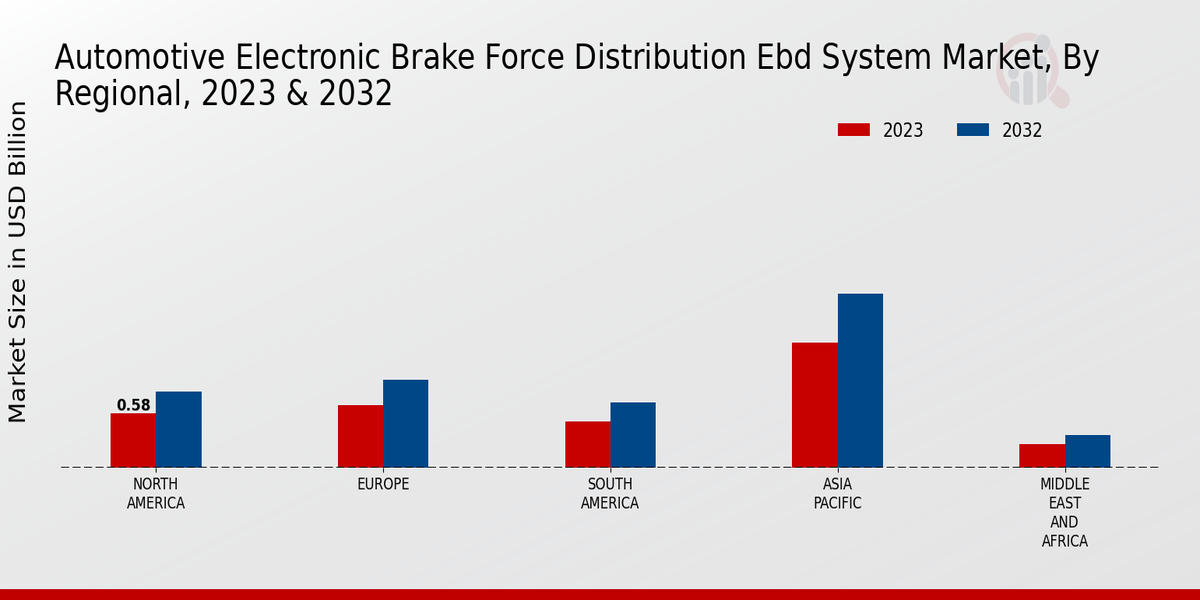Market Growth Projections
The Global Automotive Electronic Brake Force Distribution (EBD) System Market Industry is poised for substantial growth in the coming years. With a projected market value of 3.61 USD Billion in 2024, the industry is expected to expand significantly, reaching an estimated 5.48 USD Billion by 2035. This growth trajectory indicates a compound annual growth rate (CAGR) of 3.87% from 2025 to 2035. Factors such as increasing vehicle safety standards, technological advancements, and the rising demand for electric vehicles are likely to contribute to this upward trend. The market's expansion reflects the growing importance of EBD systems in enhancing vehicle safety and performance.
Increasing Vehicle Safety Standards
The Global Automotive Electronic Brake Force Distribution (EBD) System Market Industry is experiencing growth due to the rising emphasis on vehicle safety standards. Governments worldwide are implementing stringent regulations to enhance road safety, which necessitates advanced braking systems. For instance, the European Union has mandated that all new vehicles must be equipped with electronic stability control systems, which include EBD. This regulatory push is likely to drive the adoption of EBD systems, contributing to the market's projected value of 3.61 USD Billion in 2024. As safety becomes a priority, manufacturers are compelled to integrate EBD technology into their vehicles.
Growing Demand for Electric Vehicles
The shift towards electric vehicles (EVs) is significantly influencing the Global Automotive Electronic Brake Force Distribution (EBD) System Market Industry. EVs require advanced braking technologies to manage their unique weight distribution and regenerative braking systems effectively. EBD systems are essential in optimizing braking performance in these vehicles, ensuring safety and efficiency. As the global EV market expands, driven by consumer demand and government incentives, the adoption of EBD systems is expected to rise. This trend aligns with the market's anticipated growth, with a compound annual growth rate (CAGR) of 3.87% projected from 2025 to 2035, indicating a robust future for EBD technology in the EV sector.
Rising Consumer Awareness of Vehicle Safety
Consumer awareness regarding vehicle safety is a significant driver for the Global Automotive Electronic Brake Force Distribution (EBD) System Market Industry. As individuals become more informed about the benefits of advanced braking systems, they are increasingly prioritizing safety features when purchasing vehicles. This shift in consumer behavior compels manufacturers to incorporate EBD systems into their offerings to meet market expectations. The growing demand for safer vehicles is likely to propel the market forward, contributing to the projected value of 3.61 USD Billion in 2024. As safety becomes a key purchasing criterion, the integration of EBD technology is expected to rise, reflecting changing consumer preferences.
Technological Advancements in Automotive Systems
Technological innovations play a pivotal role in shaping the Global Automotive Electronic Brake Force Distribution (EBD) System Market Industry. The integration of advanced sensors and control algorithms enhances the performance of EBD systems, allowing for better distribution of braking force based on load conditions. For example, the development of adaptive braking systems that can adjust in real-time to driving conditions is becoming increasingly prevalent. This trend is expected to contribute to the market's growth, with a projected value of 5.48 USD Billion by 2035. As manufacturers invest in research and development, the capabilities of EBD systems are likely to expand, further driving market demand.
Expansion of Automotive Manufacturing in Emerging Markets
The expansion of automotive manufacturing in emerging markets is a crucial factor driving the Global Automotive Electronic Brake Force Distribution (EBD) System Market Industry. Countries such as India and Brazil are witnessing a surge in vehicle production, fueled by increasing disposable incomes and urbanization. This growth presents opportunities for EBD system integration as manufacturers seek to enhance vehicle safety and performance. As these markets develop, the demand for advanced braking technologies is likely to rise, contributing to the market's growth trajectory. The anticipated increase in production volumes in these regions aligns with the overall market growth, positioning EBD systems as a vital component in the evolving automotive landscape.
















Leave a Comment